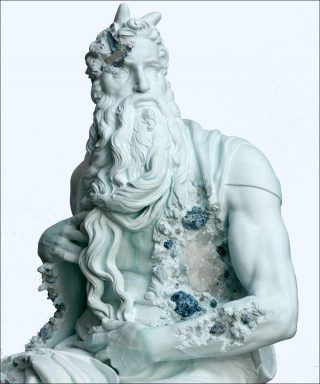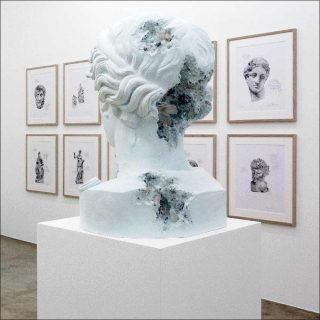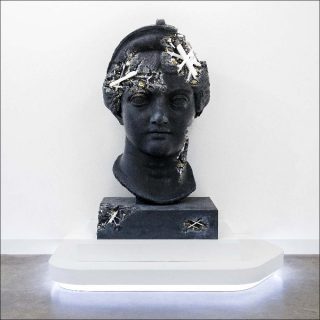 |
Daniel Arsham, Blue Calcite Eroded Moses, 2019
|
Daniel Arsham's eroded sculptures reproduce some of the world's great sculptural treasures, and is the perfect exhibition to see on return from a trip to Rome. The young American artist apparently gained access to the French molding atelier, the Réunion des Musées Nationaux - Grand Palais, that reproduces masterpieces for Europe's major encyclopeadic museums. Using the same molds and scans, Arsham casts perfect replicas of famous sculptures in hydrostone, a kind of uncoated terracotta clay. He then chisels erosions into the sculpture, exposing crystals of blue calcite, selenite, and quartz. The result is figures that are both disintegrating and, simultaneously, showing their mode of construction. They are both eroding and revealing their increased value, icons whose infinite reproduction and copying is in itself as much a cultural phenomenon as the object itself.
 |
| Daniel Arsham, Blue Calcite Eroded Melpomene, 2019 |
Having just returned from Rome, I couldn't help thinking of the gallery upon gallery of cultural riches at the Vatican museums. The endless rows of heads, animals, ancient gods and then the tapestries, paintings and sculptures acquired by each pope, adding to those already amassed from the previous one in the Vatican museums are the ultimate glut of accumulated objects. These collections that announce, "this is mine, I own it," is both the subject of Arsham's laughter and his critique of our readiness to consume everything in sight. On the one hand, the artist is showing the way that these relics are crumbling and disintegerating thanks to our unrelenting idolization, and on the other hand, with the sparkle of the precious crystalline stones discovered inside the objects, they are offered up to be further revered.
 |
| Daniel Arsham, Rose Quartz Eroded Venus de Milo, 2019 |
It is striking to notice that Arsham is doing the same thing with each of his reproduced statues.There is no differentiation between them, other than of course their form. But they are all the same material, they all go through the same process. To the point where, once we have seen one of these objects, we have seen them all. Nothing new is revealed by moving on to the next one. Except of course the fact that the repetition is itself a comment on the practices and processes of reproduction and adoration. The repetition might trivialize these great works of art, but it also gives them value. Furthermore, Arsham comments on our own behaviour in museums as both diminishing and elevating the value of objects on display. Rather than examining the work for its artistic qualities, we move to the next one, asking "who is it," ignoring its aesthetic qualities and historical significance in preference for "spotting the great work of art."
 |
Daniel Arsham, Ash and Pyrite Eroded Head of Lucille, 2019
|
Arsham titles the exhibition, Paris 3020, in a clear gesture towards the future of these relics. In 1000 years, the art lovers of Paris will be traipsing off to see the works, even as they disintegrate and lose all materiality. And yet, Arsham is also surely critiquing the present. These are the past works idealized in the present, made over and over and over again, not just by the RMN, but in the form of miniatures, key rings, light shades, and the list goes on. They are also reproduced in every material - metal and plastic being the most popular. We can never get enough of the iconic treasures of yesterday. |
Daniel Arsham, Paris, 3020
Installation View @ Perrotin Paris |
Arsham's work typically represents the decay of the objects and icons that we blow out of proportion through our adoration: footballs, computers and televisions, for example. All of these objects have a lifespan that makes them immanently disposable - at least that's what he draws attention to. But when those objects are centuries' old museum statues that are being reproduced for encyclopeadic museums, they take on a whole new dimension. Arsham's works become about collection, exhibition and reproduction, and in turn, how each of these practices diminish and exaggerate the value, destroy and recreate the importance of art.





No comments:
Post a Comment